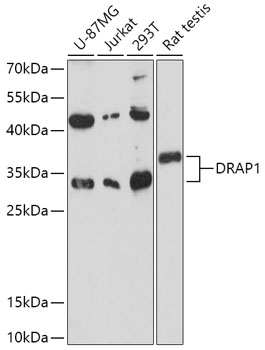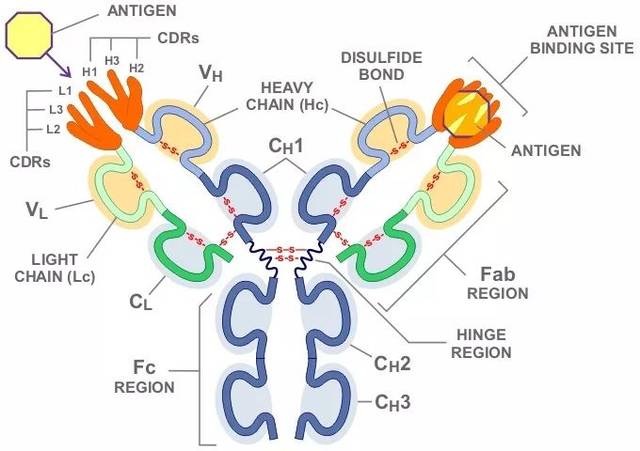Product Name :
DRAP1 polyclonal antibody Background :
Transcriptional repression is a general mechanism for regulating transcriptional initiation in organisms ranging from yeast to humans. Accurate initiation of transcription from eukaryotic protein-encoding genes requires the assembly of a large multiprotein complex consisting of RNA polymerase II and general transcription factors such as TFIIA, TFIIB, and TFIID. DR1 is a repressor that interacts with the TATA-binding protein (TBP) of TFIID and prevents the formation of an active transcription complex by precluding the entry of TFIIA and/or TFIIB into the preinitiation complex. The protein encoded by this gene is a corepressor of transcription that interacts with DR1 to enhance DR1-mediated repression. The interaction between this corepressor and DR1 is required for corepressor function and appears to stabilize the TBP-DR1-DNA complex. [provided by RefSeq, Jul 2008] Product :
1mg/ml in PBS with 0.02% sodium azide, 50% glycerol, pH7.2 Storage&Stability :
Store at 4°C short term. Aliquot and store at -20°C long term. Avoid freeze-thaw cycles. Specificity :
Unmodification Immunogen :
Recombinant fusion protein of human DRAP1(NP_006433.2). Conjugate :
Unconjugated Modification :
Unmodification
DRAP1 polyclonal antibody Background :
Transcriptional repression is a general mechanism for regulating transcriptional initiation in organisms ranging from yeast to humans. Accurate initiation of transcription from eukaryotic protein-encoding genes requires the assembly of a large multiprotein complex consisting of RNA polymerase II and general transcription factors such as TFIIA, TFIIB, and TFIID. DR1 is a repressor that interacts with the TATA-binding protein (TBP) of TFIID and prevents the formation of an active transcription complex by precluding the entry of TFIIA and/or TFIIB into the preinitiation complex. The protein encoded by this gene is a corepressor of transcription that interacts with DR1 to enhance DR1-mediated repression. The interaction between this corepressor and DR1 is required for corepressor function and appears to stabilize the TBP-DR1-DNA complex. [provided by RefSeq, Jul 2008] Product :
1mg/ml in PBS with 0.02% sodium azide, 50% glycerol, pH7.2 Storage&Stability :
Store at 4°C short term. Aliquot and store at -20°C long term. Avoid freeze-thaw cycles. Specificity :
Unmodification Immunogen :
Recombinant fusion protein of human DRAP1(NP_006433.2). Conjugate :
Unconjugated Modification :
Unmodification
-
 Western blot analysis of extracts of various cell lines, using DRAP1 antibody at 1:1000 dilution.
Western blot analysis of extracts of various cell lines, using DRAP1 antibody at 1:1000 dilution.
Secondary antibody: HRP Goat Anti-Rabbit IgG at 1:10000 dilution.
Lysates/proteins: 25ug per lane.
Blocking buffer: 3% nonfat dry milk in TBST.
Detection: ECL Basic Kit .
Exposure time: 3min.
Bioworld Biotech only provide peptides for our antibodies and do not provide additional peptide customization services.
Price/Size :
USD 368/1mg/vial
Tips:
For phospho antibody, we provide phospho peptide(0.5mg) and non-phospho peptide(0.5mg).Describe :
Blocking peptides are peptides that bind specifically to the target antibody and block antibody binding. These peptide usually contains the epitope recognized by the antibody. Antibodies bound to the blocking peptide no longer bind to the epitope on the target protein. This mechanism is useful when non-specific binding is an issue, for example, in Western blotting (WB) and Immunohistochemistry (IHC). By comparing the staining from the blocked antibody versus the antibody alone, one can see which staining is specific; Specific binding will be absent from the western blot or IHC performed with the neutralized antibody.Formula:
Synthetic peptide was lyophilized with 100% acetonitrile and is supplied as a powder. Reconstitute with 0.1 ml DI water for a final concentration of 10 mg/ml.The purity is >90%,tested by HPLC and MS.
Storage:
The freeze-dried powder is more stable. For short time at 2-8°C. For long term storage store at -20°C.
Note :
This product is for research use only (RUO only). Not for use in diagnostic or therapeutic procedures.
 DRAP1 polyclonal antibody
DRAP1 polyclonal antibody  Datasheet
Datasheet COA
COA MSDS
MSDS SHIP
SHIP